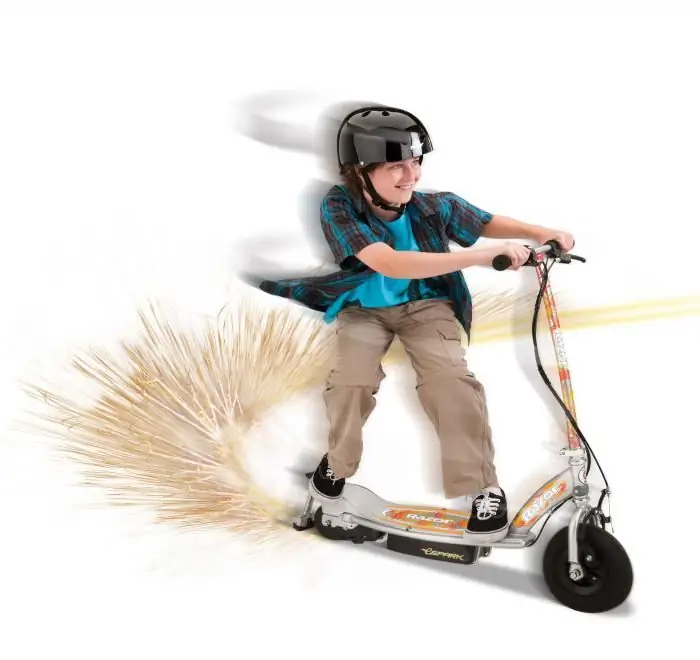2025 Author: Erin Ralphs | [email protected]. Last modified: 2025-01-22 21:14:12
In our time, when the streets of Russian cities were filled with scooters made mainly in Southeast Asia, somehow I can’t even believe that our country also once produced similar cars, only they were called scooters. One of these two-wheeled vehicles was the Vyatka motor scooter.

History of Appearance
Vyatka owes its birth to the Italians. Post-war Italy needed vehicles that everyone could afford. As a result, at one of the surviving Piaggio enterprises, which was engaged in the production of fighters during the war, they began to produce a new two-wheeled vehicle, which was fundamentally different from such familiar motorcycles. The first Vespa (Wasp) scooters appeared on Italian roads as early as April 1946. They have become extremely popular not only in their own country, but also abroad.
It must be said that the design of a scooter is significantly different from the design of a motorcycle. Low center of gravity and smallthe diameter of the wheels and the long footwell make it very stable. In addition, deep guards on both wheels, as well as a large front guard, protect the rider and passenger from road grime.
Vespa in USSR
At the end of the fifties, during the reduction of the army and traditional types of weapons, it was decided to start producing consumer goods at some defense enterprises. So, in 1956, a decree of the Council of Ministers of the USSR and an order of the Ministry of Defense Industry appeared, according to which the Vyatka-Polyansky machine-building plant, located in the Kirov region, was ordered to start producing scooters as soon as possible.

"".
The products of the Vyatka-Polyana masters differed slightly from the prototype, mainly in weight and dimensions (heavier by 7 kg and with a wheelbase, more by 4 cm). In addition, a flag with a star was located on the front fender, a round one was installed instead of an oval speedometer, the ignition switch was located on the steering wheel (and not in the headlight housing), the central part of the steering wheel and the headlight were somewhat larger. In general, the design was similar to its Italian relative.
Like the Vespa, the engine of the Vyatka scooter was located on the right under a convex protective cover. On the other hand, for symmetry, there wasthe same casing under which the spare wheel was located. The gas tank was in the back of the body. To change gears, a handle on the steering wheel was used. Kickstarter was used to launch.
The Vyatka scooter was equipped with a single-cylinder two-stroke engine with a forced air cooling system with a working volume of 155 cm3, which developed a power of 5.5 liters. With. and accelerated the scooter to 60 km / h in 19 seconds. Gasoline consumption was 3.1 liters per 100 km. The fuel was low-octane A-66 gasoline.
In general, the design turned out to be quite successful, by 1961 100 thousand cars had already been produced. The Vyatka scooter had a low cost. In the sixties, it could be purchased for 320 rubles, which is much lower than any motorcycle. The production of Vyatka ceased in 1966, and was replaced by the Electron scooter.

Vyatka tricycle
Based on the two-wheeled model, a three-wheeled modification was made in 1959, and in several versions - a van, a loading platform and a dump truck. The three-wheeled Vyatka scooter could carry up to 250 kg of cargo and accelerated to a speed of 35 km/h.
Also, on the basis of Vyatka, a motorcycle taxi was created, in which two wheels were located in front and were swivel. Between the wheels was a seat for passengers. True, only 50 such taxis were created.
Recommended:
Italian cars: review, rating, models, names

What are the first associations that come up when talking about Italian cars? Of course, "Lamborghini" and "Ferrari". However, in addition to these two companies, there are many other automotive companies in Italy. Well, it is worth briefly talking about each of them and listing their most famous models
Ducati Monster - a masterpiece of the Italian motorcycle industry

Ducati Monster is one of the best representatives of such a vehicle as a motorcycle. On it, each person will feel comfortable and confident, and on any road
"Ferrari 458" - another perfection from the world famous Italian company

"Ferrari 458" is a car equipped with everything: cruise control, CD player, powerful engine, TV, on-board computer, electric adjustment and electric drive, ABS, stability control … and this is just a small list equipment of this vehicle. Well, about what else this supercar can please potential buyers, it’s worth talking in more detail
Electric scooter - reviews. Electric scooter for adults. Electric scooter for children

No matter which electric scooter you choose, it will allow you to enjoy relaxing walks in the park or immerse yourself in the world of outdoor activities
Legendary Italian car "Lamborghini"

Lamborghini cars from the time of their creation to the present day are bright innovators in the world of sports cars, and since 2018 in the SSUV class. Most of the world's population wants to own such cars. Lamborghini are always stylish, recognizable, daring and very fast

